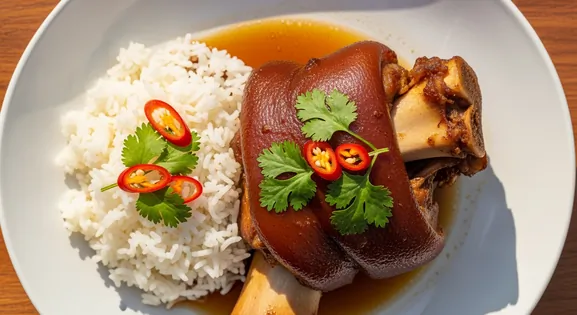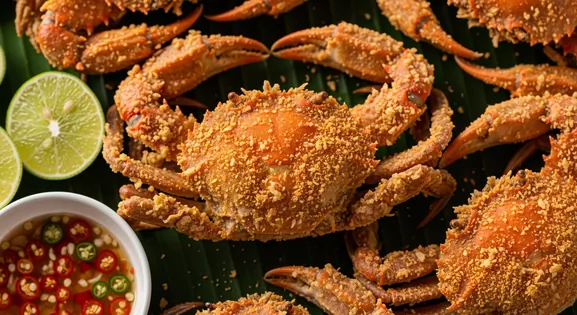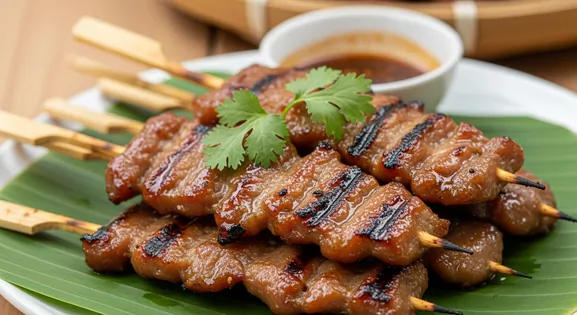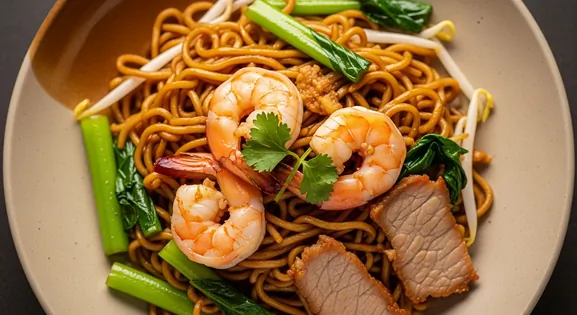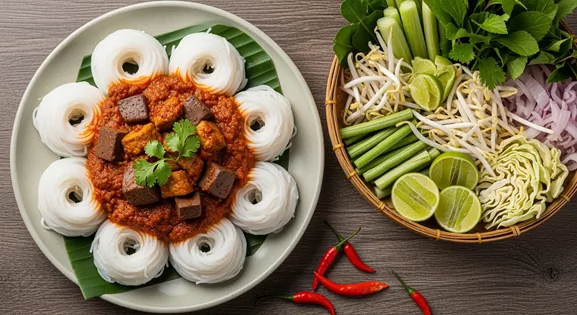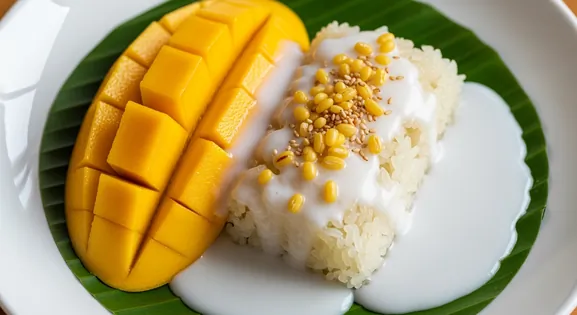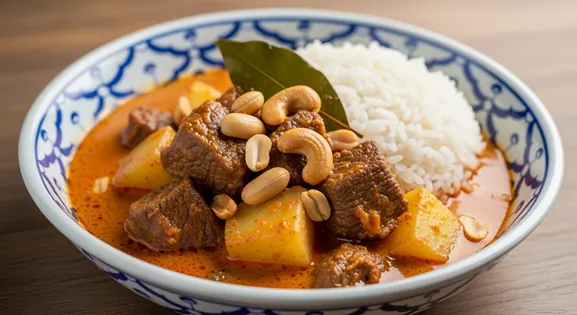Boat Noodles in Thailand: A Complete Food Lover's Guide
ก๋วยเตี๋ยวเรือ (Kuay Teow Reua)
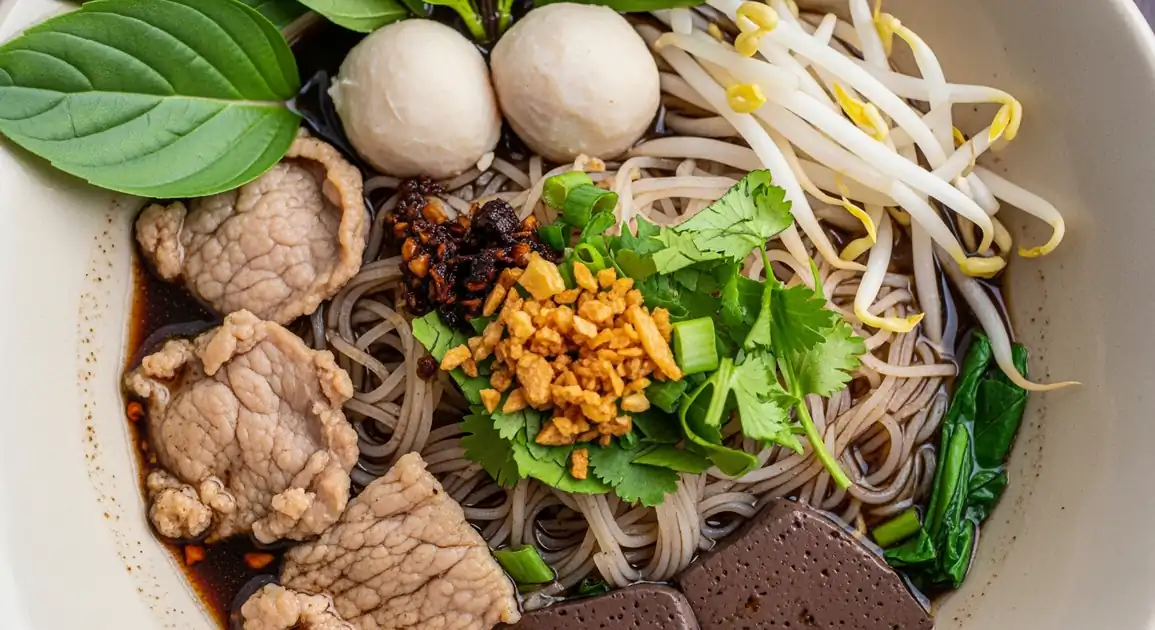
About Boat Noodles
Kuay Teow Reua, or Boat Noodles, is an iconic Thai noodle soup renowned for its intense, complex broth, often dark and rich due to the inclusion of 'Nam Tok' (pig's or cow's blood). Served typically in small bowls, it features rice noodles (commonly 'Sen Lek'), tender slices of pork or beef, meatballs, morning glory, and fragrant garnishes like fried garlic and cilantro. The taste profile is a signature Thai balance of savory, sweet, sour, and spicy, highly customizable via tableside condiments.
Tracing the Roots of Boat Noodles
Originating along the canals (khlongs) of Bangkok and surrounding areas like Ayutthaya, vendors prepared and served this dish directly from small boats. The small bowls facilitated easy handling and prevented spills. As Bangkok's canals were filled in, vendors moved ashore, often setting up near former waterways or transport hubs like Victory Monument. Ayutthaya remains a key center for enjoying Boat Noodles, often associated with slightly richer, sometimes sweeter, broth variations.
Crafting the Perfect Dish
A master broth is meticulously prepared by simmering pork or beef bones with herbs and spices like galangal, lemongrass, pandan leaves, cilantro roots, star anise, and cinnamon. To order, rice noodles and selected meat (pork/beef slices, meatballs, liver) are quickly blanched. These are placed in a small bowl, often coated with dark soy sauce and fried garlic oil. Hot broth is ladled over, and optionally, 'Nam Tok' (blood mixture) is stirred in for richness. Garnishes like blanched water spinach/morning glory, bean sprouts, fried garlic, cilantro, and sometimes crispy pork skin are added. It's served immediately with a condiment caddy.
Key Ingredients of Boat Noodles
Rice Noodles (Sen Lek)
These thin, flat rice noodles are the foundation of the dish, providing a satisfying chewiness. They absorb the rich broth and flavors, offering a comforting texture.
Quality indicator: Quality noodles are distinct, not clumpy or mushy, and retain a slight bite.
Nam Tok (Blood)
A crucial ingredient for authentic Boat Noodles, 'Nam Tok' refers to fresh pig's or cow's blood added to the broth. It thickens the soup and imparts a unique, deep, savory richness.
Quality indicator: When added to piping hot broth, it should blend seamlessly, creating a dark, opaque, and velvety texture.
Pork or Beef (Moo/Neua)
Tender slices of pork or beef, along with meatballs and sometimes liver, provide the primary protein. The meat is typically blanched quickly in the hot broth.
Quality indicator: Look for lean, fresh-looking slices of meat and firm, well-formed meatballs that are cooked through.
Local Boat Noodles Variations in Thailand
Boat Noodles with Blood
The classic version, featuring broth enriched and thickened with pig's or cow's blood.
Boat Noodles Clear Soup
A variation made without blood, resulting in a lighter, clearer, though still flavorful broth.
Pork Boat Noodles
Made with pork broth, sliced pork, pork liver, and pork balls.
Beef Boat Noodles
Made with beef broth, sliced beef, beef liver (less common), and beef balls.
Boat Noodles Dry
Less common for traditional boat noodles but possible: noodles are served tossed in sauces and toppings with a small amount of broth on the side.
Enhancing the Flavor: Classic Pairings
Crispy Pork Rinds (Kap Moo)
side_dish
These crunchy, airy pork rinds are a popular accompaniment, adding a delightful textural contrast and savory depth when crumbled into the soup or eaten alongside.
Thai Iced Tea (Cha Yen)
beverage
The sweet, creamy, and refreshing Thai iced tea provides a perfect counterpoint to the rich, savory, and often spicy flavors of Boat Noodles, cleansing the palate.
Universal Quality Indicators
What to Look For
-
Constantly simmering, hot broth
Ensures ingredients are cooked properly and minimizes bacterial growth. Look for visible steam and bubbling.
-
Vendor cooks noodles and meat fresh per order
Guarantees the core ingredients are freshly cooked and served hot, not sitting around.
-
High customer turnover, especially locals
Indicates the food is popular and ingredients are likely replenished frequently, ensuring freshness.
-
Clean condiment caddy (bottles, spoons, containers)
Condiments are added directly to your bowl. Ensure they look fresh and containers are clean, not sticky or attracting flies.
-
Fresh-looking meat and vegetables
Check that the sliced meat, meatballs, and greens displayed look fresh and are handled hygienically.
What to avoid
-
Lukewarm or non-simmering broth
Broth that isn't kept sufficiently hot indicates a potential quality concern.
-
Pre-cooked noodles or meat sitting out
Ingredients should be cooked upon ordering, not prepared in advance and left at room temperature.
-
Dirty stall area or utensils
A general lack of cleanliness, including sticky surfaces or unwashed utensils, can indicate poor overall hygiene practices.
-
Condiments look old, discolored, or attract flies
Avoid using condiments that appear stale, dirty, or contaminated.
-
Vendor handles money and food without washing hands/changing gloves
Poor hand hygiene is a major source of cross-contamination.
Explore Boat Noodles in Detail: City Guides
Discover where to find the best Boat Noodles and learn local tips in these cities:
Dietary Information
Dietary Information
Important Note for Travelers: Your safety is our priority. Below are the common allergens associated with the traditional preparation of this dish. However, recipes and ingredients can vary significantly between establishments. Always confirm all ingredients directly with the food vendor before ordering, especially if you have a severe allergy.
Potential Allergens
Dietary Suitability
How to Order Boat Noodles
Frequently Asked Questions about Boat Noodles
What exactly are Thai Boat Noodles (Kuay Teow Reua)?
Boat Noodles are a famous Thai noodle soup with a rich, intense broth, often thickened with pig's or cow's blood ('Nam Tok'). Served in small bowls with rice noodles, meat, and vegetables, it offers a complex balance of savory, sweet, sour, and spicy flavors, customizable with table condiments.
How can I ensure quality when eating Boat Noodles, especially with blood?
To ensure quality, choose busy vendors where the broth is kept simmering hot. Verify meat looks fresh and is cooked to order. The 'Nam Tok' (blood) should be added to the hot broth just before serving. Look for clean stalls and well-maintained condiment stations.
What is 'Nam Tok' in Boat Noodles?
'Nam Tok' is the addition of fresh pig's or cow's blood to the soup. It's mixed with salt or lemongrass juice to prevent coagulation and added to the hot broth. This enriches the broth, thickening it slightly and imparting a deeper, savory flavor. It's a key characteristic of classic Boat Noodles.
How spicy are Boat Noodles?
The base broth typically has some chili but isn't overly spicy. However, Boat Noodles are always served with a condiment caddy containing dried chili flakes, chili vinegar, sugar, and fish sauce. This allows you to fully customize the spice level and flavor balance to your exact preference.
What types of noodles and meat are commonly used?
Common noodles include thin rice noodles ('Sen Lek'), fine rice vermicelli ('Sen Mee'), and wide flat rice noodles ('Sen Yai'). Meat choices are typically pork ('Moo') or beef ('Neua'), featuring sliced meat, liver, and meatballs.
Are Boat Noodles gluten-free?
Boat Noodles are typically made with rice noodles, which are naturally gluten-free. However, soy sauce used in the broth may contain wheat, and there's always a possibility of cross-contamination in busy street kitchens. If you require strict gluten-free, exercise caution and inform the vendor if possible, though communication might be difficult.
Expert How-To Guides about Boat Noodles
How to Spot a Good Boat Noodle Vendor
Learn to identify reputable vendors who are likely to serve delicious, authentic, and hygienically prepared Boat Noodles, ensuring a great culinary experience.
- Look for specialization: Stalls primarily serving only Boat Noodles are often experts.
- Check the broth: It should be visibly simmering in a large pot, indicating it's kept hot.
- Observe the crowd: Busy stalls with high turnover (especially locals) suggest fresh ingredients and popular taste.
- Small bowl tradition: Vendors adhering to the small bowl servings often maintain traditional recipes.
- Cleanliness check: Assess the general cleanliness of the stall, utensils, and condiment area.
- Condiment caddy: A well-stocked, clean caddy (sugar, fish sauce, chili flakes, chili vinegar) is essential.
Customizing Your Bowl of Boat Noodles
Master the art of tailoring your Boat Noodles' flavor profile using the traditional tableside condiments, just like a local would.
- Start with a small taste: Sample the broth first before adding anything.
- Add spice carefully: Use dried chili flakes ('Prik Bon') for heat – start with a tiny amount.
- Balance with sourness: Add chili vinegar ('Prik Nam Som') for a tangy kick.
- Enhance saltiness: Use fish sauce ('Nam Pla') sparingly if needed.
- Adjust sweetness: Add a little sugar ('Nam Tan') to round out the flavors – common in Thai cuisine.
- Mix well: Stir thoroughly after adding condiments.
- Specify preferences when ordering: Ask for noodle type ('Sen Lek'), meat ('Moo'/'Neua'), with/without blood ('Sai Luad'/'Mai Sai Luad').
Eating Boat Noodles Smartly
Gain confidence in enjoying Boat Noodles by understanding key quality indicators and making smart choices for a delicious meal.
- Choose busy vendors: High turnover ensures fresher ingredients and hotter broth.
- Ensure it's cooked to order: Noodles and meat should be blanched/cooked right before serving.
- Verify broth temperature: Make sure the broth is actively simmering.
- Be cautious with blood ('Nam Tok'): Ensure it's added to piping hot soup. If hesitant, order without ('Mai Sai Luad').
- Check condiment cleanliness: Avoid sticky bottles or old-looking chili flakes/vinegar.
- Start with less spice: You can always add more chili, but you can't take it away.
- Observe vendor hygiene: Look for clean hands/gloves and separation of raw/cooked items.
Our Commitment to Quality
At Tasteplorers, our mission is to provide the most accurate and useful travel information in the world. To achieve this, all content on this site is created through our unique editorial framework. We utilize leading AI research tools, guided by our proprietary prompts, and a multi-stage validation process. This entire system is overseen by our editorial team to ensure everything we publish meets our high standards for accuracy, cultural nuance, and practical value for travelers.
Learn more about our Editorial Process and our Mission.
Countries
Explore regions
Europe
Discover Europe's diverse culinary landscape, from Mediterranean flavors to hearty Alpine fare. Learn to navigate markets, decode menus, and eat like a local.
Latin America & Caribbean
Discover the vibrant cuisines of Latin America & the Caribbean. Our expert guide covers everything from Mexican street food to Peruvian ceviche and market tips.
Oceania
Explore Oceania's diverse food scene. Learn about Polynesian earth ovens, Fijian feasts, and the vibrant café culture of Australia and New Zealand.
Southeast Asia
Explore Southeast Asia's diverse food cultures from Thailand to Vietnam. Get expert tips on navigating spice levels, choosing quality vendors, and understanding the rich traditions of the region.
